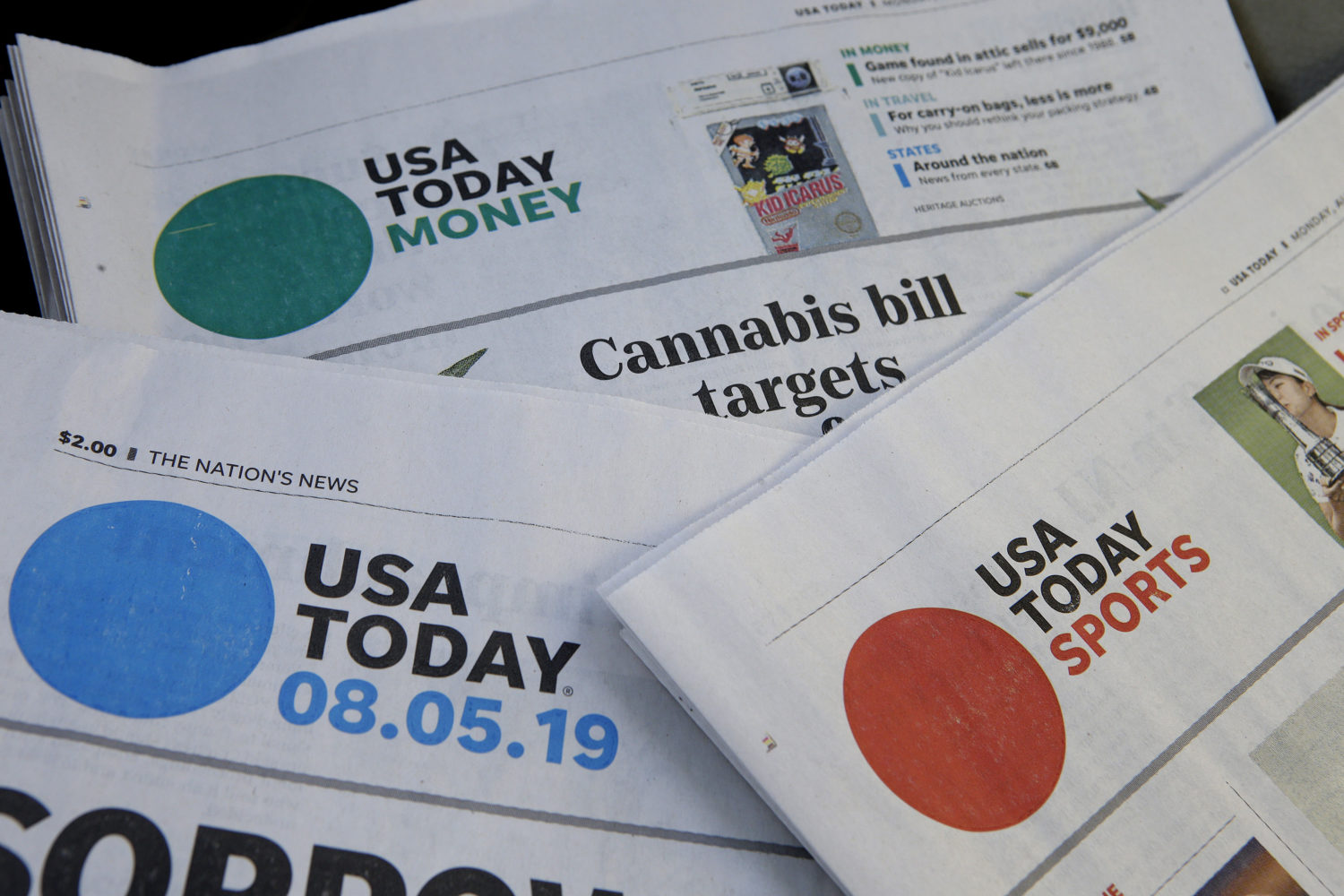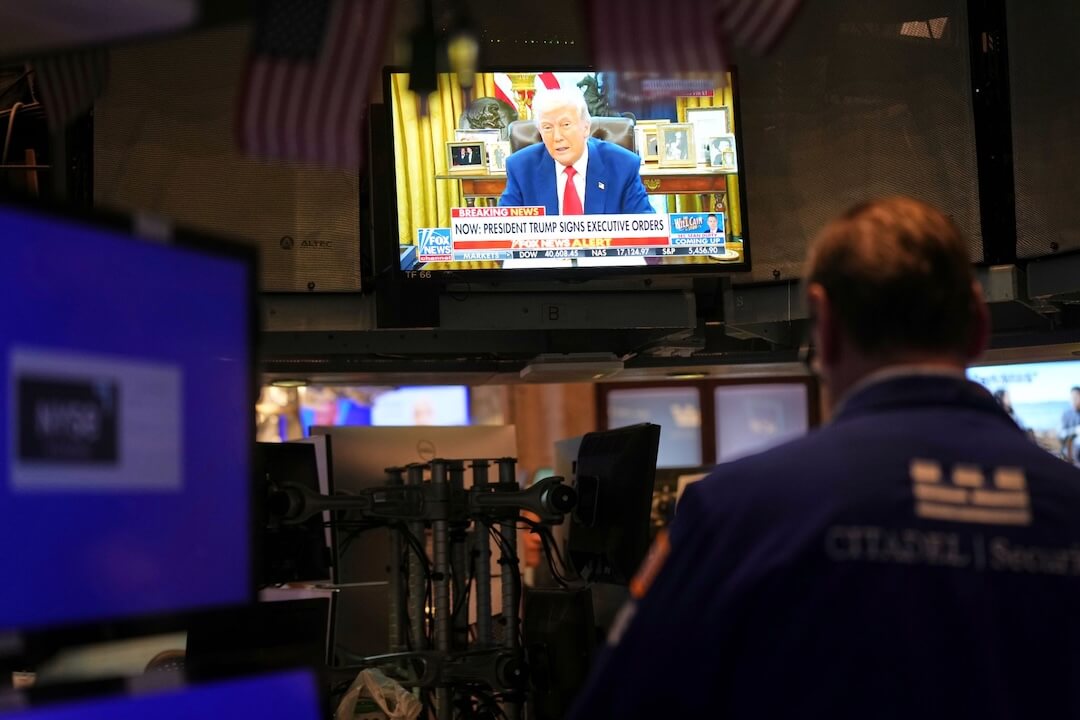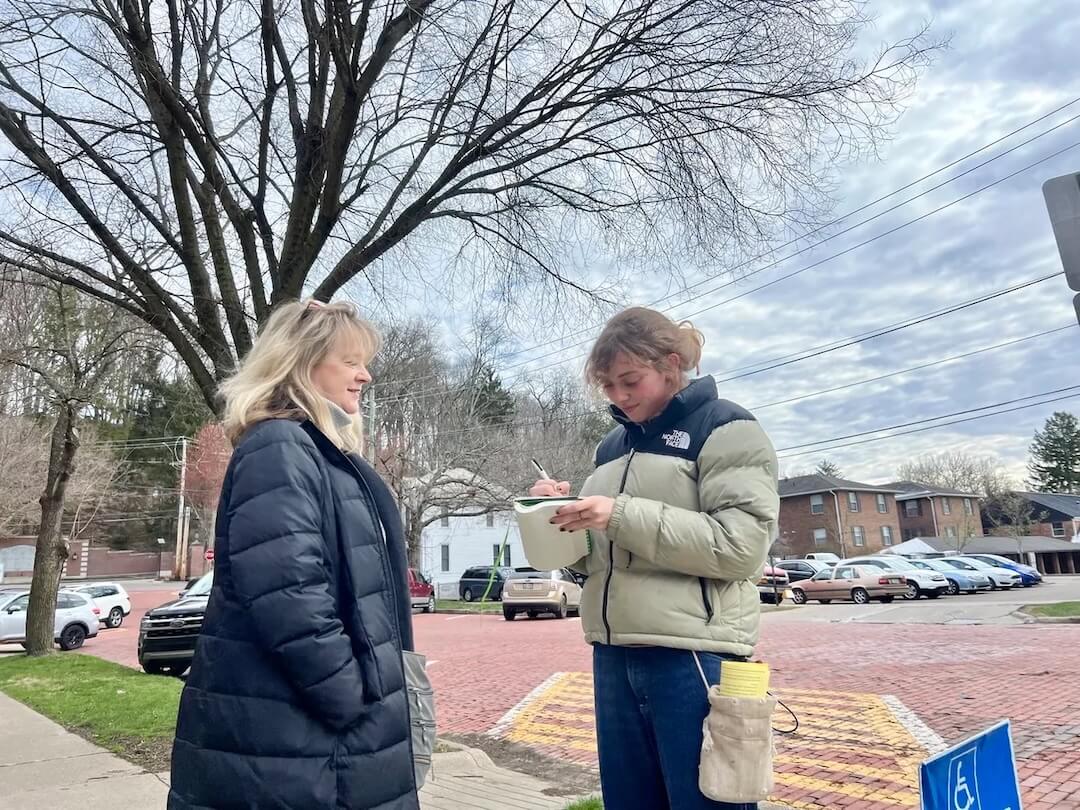This story has been updated.
After a nearly 40-year run, USA Today and its digital sites are about to undergo a major restructuring that will include building up digital marketing while phasing out the print edition.
The deal for GateHouse’s parent, New Media Investment Group, to acquire Gannett, which owns USA Today, will not close for at least another month. Nothing much will happen — or legally can happen — until then, and don’t look for this to be the new company’s first order of business. Winding print down could take several years.
But two knowledgeable sources, talking on background, said a move away from USA Today in print is part of the calculations for the new enterprise. It makes a lot of sense, given the print edition’s deteriorating paid circulation and minimal advertising.
Maribel Perez Wadsworth, USA Today publisher, commented via email:
“Gannett has no plans to discontinue the print edition of USA TODAY, which remains an important part of our business. Gannett remains committed to high-quality journalism for the communities we serve and our ongoing digital transformation, and we are pleased to have found a like-minded partner in New Media. We believe the combination of our two companies will transform the landscape in the print and digital news business and, following the close of the transaction, we look forward to delivering on the compelling benefits for audiences, customers, employees and shareholders.”
Gannett and USA Today leaders have called a staff meeting for 11:30 a.m. Thursday to dispute the findings of this article and answer questions. (The text of that announcement is at the end of this story.)
[the_ad id=“667826”]
Already set in motion are moves to try membership opportunities and marketing add-ons to boost revenue.
One Gannett editor, speaking on background, told me that new CEO Paul Bascobert streamed an all-hands meeting to regional papers on the day that his hiring and the deal agreement were simultaneously announced.
“It ran for an hour and a quarter,” the editor said, “and not once was there a single mention of print.”
“Digital transformation” has been often promised and rarely delivered many times over at Gannett — and at other chains. But even before the merger came together, the same editor said that Gannett had moved to going all in for digital: “Let’s face reality. We’re (still) going to have to radically transform.”
Bascobert, while silent publicly, has been highly visible and proactive in internal meetings with Gannett execs and visits to the largest of its 109 regional papers.
“He has indicated that he is not impressed with USA Today,” a source familiar with the meetings told me. “He said ‘middle-of-the-road is not a strategy.’” (That could apply either to both-sides-of-the-matter reporting and opinion pieces, or to a mainstream mid-market position.)
On the business side, the 109 regional paper sites, which draw on USA Today for national content, are beginning to build the number of paid digital subscriptions. Those stand at 561,000, the company has said in its most recent earnings report, after a slow start.
And the company claims a monthly unique audience of 127 million for all of its sites.
This spring at larger circulation regionals, Gannett quietly dropped a standalone section of USA Today news at its 35 largest papers. The effort, code-named Project Butterfly, had been been highly touted as a reinvestment in print when it began in 2013.
[the_ad id=“667872″]
That move by itself constitutes a significant print cutback, wiping away distribution of hundreds of thousands of copies. The sections were simply too expensive, another editor told me, compared to the revenue they generated.
USA Today’s main site remains free, monetized by high-volume ads with geo-targeted options.
Declining print circulation numbers paint a picture of why winding down the five-day-a-week print edition in an orderly way would be attractive to the merged company.
In its latest audited circulation report earlier this year, USA Today reported individually paid circulation of 178,000 with another 342,000 of hotel distribution (for which the hotel chains pay a substantially reduced rate).
That 520,000 is a long fall from the more than 2,289,000 USA Today claimed in 2007, when it was running neck-and-neck with the Wall Street Journal as tops in paid circulation.
Also, if you thumb through increasingly thin editions, it is clear that most days USA Today in print carries little or no fully paid advertising.
Figures for the expense side are not available. But think about the probable cost of printing and distributing all over the country. USA Today can piggyback on plants at its regional papers in many places. Elsewhere, however, it needs to contract for printing and delivery.
State-by-state figures, part of the circulation report to the Alliance for Audited Media for the second quarter, show that the paper does indeed deliver on its promise to be available all over the country.
In all 50 states readers can get a copy of USA Today in print. Totals range from a low of 266 in Montana to more than 49,000 in California.
[the_ad id=“667878”]
A third Gannett editor said, “I’ve been told that the hotel print distribution still makes money. But if it doesn’t, there is basically nothing left.”
One argument for staying in print, another editor told me, is its contribution to branding and supporting the influence of reporting and editorials on local affairs. While USA Today is no doubt a well-established brand, the benefit for credibility with a national, rather than local, audience is less obvious — and may simply be too expensive.
Newspapers in the Advance chain began flipping to three-day-a-week print delivery seven years ago, getting strong pushback from readers and local public officials. In New Orleans, Advance’s Times-Picayune was sold May 1 to its rival, The Advocate.
As I reported in January, the rest of the industry did not follow Advance’s lead. Since then, moving away from print has gathered some momentum. The Pittsburgh Post-Gazette has shifted to three days a week in print. A number of McClatchy’s 30 papers are dropping Saturday editions.
GateHouse and Gannett executives have promised $275 million to $300 million in cost saving “synergies” as a rationale for the merger. Eliminating, or even just scaling back USA Today in print, would add up to a healthy downpayment on that goal.
Phasing out print would doubtless lead to some downsizing of USA Today’s news staff of 289 (according to a staff directory), many at the company’s headquarters in McLean, Virginia, others at bureaus around the country.
However, the demand for much of the content in digital formats — mobile especially — will remain. Distributing national stories to the regional papers would still make sense, and those can be offered to the 260 GateHouse outlets.
Gannett and its USA Today Network have gradually established a substantial 21-person investigative team, often drawing on both the reporting resources of the regional papers and a centralized data and editing team.
That structure won the USA Today Network, collaborating with The Arizona Republic, a 2018 Pulitzer for explanatory reporting for a series of stories and digital visuals on the four-state Mexican border, titled “The Wall.”
The most recent of these projects focused on domestic violence in the NFL and the league’s response and abuses in reverse mortgages, and lobbying by the Catholic Church and the Boy Scouts against stronger child abuse laws.
GateHouse, too, has been building a national-to-local investigative unit with a target of 35 journalists. Look for the two to be put together.
Gannett editors I spoke with have formed a positive impression of new CEO Bascobert. He is 55, with a strong digital and engineering background. Though not a journalist himself, he indicates enthusiasm for the company’s journalistic ambitions.
He comes not from within Gannett, as has been tradition, but from a wedding site, The Knot. There, he was part of a team of executives pivoting to an unconventional business model that allows engaged couples to order services directly and charge vendors from all over the country to be listed.
The New Media-Gannett merger is still not a sure thing. Shareholder meetings for both companies have been scheduled for Nov. 14. If approved the company will retain the Gannett name, though New Media will be in charge.
About half the $1.4 billion purchase price will be in New Media stock. New Media shares have fallen in value by 24% since the deal was announced Aug. 1. Nonetheless, Gannett management is recommending approval, in essence saying the company has no better strategic options.
GateHouse management would not comment on the USA Today changes or other elements of transition planning. Outside of carefully crafted Securities and Exchange Commission filings, there is little they are legally allowed to say while final negotiations are in process.
USA Today, launched in 1982, was the creation of Gannett’s flamboyant and expansive CEO Al Neuharth. Derided as “McPaper” for its many abbreviated news nuggets, the paper lost more than $200 million in its first five years, before eventually turning a profit.
In its early days, USA Today was admired for its full-page color weather map, a format many other papers adopted, but not much else. Even well after the paper got more gravitas, for instance with strong stories on airline safety, the image of “news lite” lingered.
It took the build-out of the investigative unit and stronger opinion and Washington coverage to earn broader recognition of what USA Today was doing journalistically.
Neuharth was also the driving force behind the Newseum, which moved in 2008 from a building across the street from the former Gannett headquarters to prime real estate and spacious quarters on Pennsylvania Avenue, a block from the National Mall in Washington, D.C.
Mired in debt, the Newseum will close at the end of this year, its exhibits to be scattered.
You could say that USA Today in print, the Newseum and Neuharth himself were extravagant relics of the healthy newspaper industry of the 1980s and 1990s — but out of step with the digital imperatives and pressed finances of the present day.
—————-
Staff meeting email:
There was a story on Poynter today that questions the future of USA TODAY print product. The headline: “Is USA Today’s print edition headed for the sunset as GateHouse and Gannett merge? Signs point to yes.”
This is not true.
Maribel (Perez Wadsworth, USA Today publisher) made this clear to the reporter in her statement:
“Gannett has no plans to discontinue the print edition of USA TODAY, which remains an important part of our business. Gannett remains committed to high-quality journalism for the communities we serve and our ongoing digital transformation, and we are pleased to have found a like-minded partner in New Media. We believe the combination of our two companies will transform the landscape in the print and digital news business and, following the close of the transaction, we look forward to delivering on the compelling benefits for audiences, customers, employees and shareholders.”
To answer any further questions, we’ll have a staff meeting tomorrow at 11:30 ET with Paul (Bascobert) and Maribel.
Dial-in instructions to come.
Correction: This story has been updated to correct Paul Bascobert’s age and the original location of the Newseum, which across the street from Gannett and USA Today’s former headquarters, not in the same building. It is currently located on Pennsylvania Avenue, a block from the National Mall in Washington, D.C. We regret the errors.
Rick Edmonds is Poynter’s media business analyst. He can be reached at redmonds@poynter.org.








Just maybe this country doesn’t need as many leftist papers as some think? If I want the best of best Trump hate, I can go to the Washington Post or NY Times.
I was a regular newstand customer for many years. I bought it mainly for their informative sports section. The other sections were nice, breezy reads but the sports was the draw. Now it is a shell of its former self.
Don’t take my hotel door mat…..
I’ll surely miss my morning comic book whene’er I’m away.
YIKES!!! You mean that USA Today is not going to be available to me in my hotel, airline club, hospital or other place anymore??? YIKES!!! YIKES!!!! ***Snore*** ZZZZZZzzzzzzz!
If it hadn’t been for Motels and Hotels, USA Today would have folded years ago.